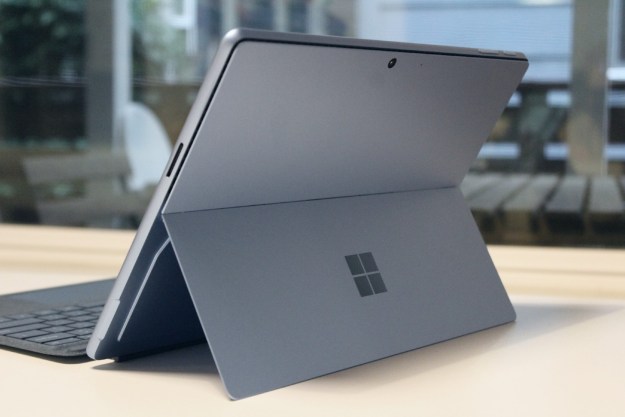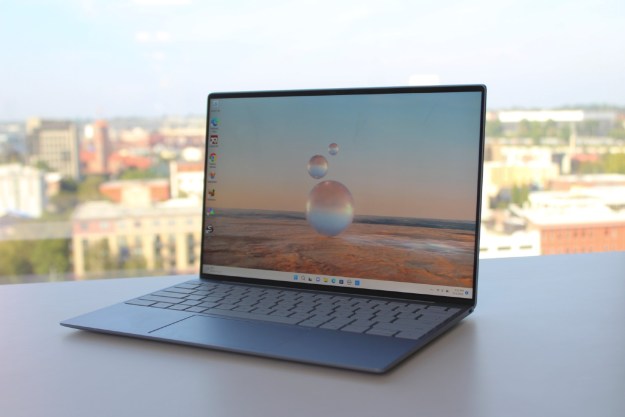In fleshing out its tablet range with the $400 Surface Go detachable PC, Microsoft now offers a decidedly cheaper option for prospective Surface buyers.
But how does the Surface Go measure up to the newer Surface Pro 7? Is it worth spending the extra bucks, or do you get what you need with the lower-cost option?
In this head to head, we pitted the Surface Go versus the Surface Pro 7 to find out where the best value for your money lies.
Design

Microsoft’s Surface Pro 7 is its latest, more expensive detachable, and we like it with good reason. It sports a fantastic chassis with a solid, premium feel that’s sleek and sturdy. It’s a little heavier than the Surface Go and measures just under two inches wider, but that doesn’t detract from it being a versatile, compact device.
The optional Type Cover has a great hinge that, when connected, lets the Surface Pro 7 open almost flat (165 degrees) with the kickstand pulled out. You can always flip the keyboard around for full tablet mode when needed, or remove it altogether.
The Surface Go is comparable in almost every way and looks near identical. At first glance, you’d be hard-pressed to tell them apart save for their apparent size differences. You may even wonder what drives the Surface Pro 7’s enhanced price tag. Is the Surface Go just a 10-inch version? No.
The Surface Go has a smaller screen at 10 inches (diagonal) versus the Pro’s 12.3-inch display. In terms of connectivity, the Surface Pro 7 offers a traditional USB-A port, alongside a microSDXC card reader, USB-C, a Surface Connect port, and a headphone jack. The Surface Go has a near-identical lineup that drops the USB-A port.
Both models support great Type Cover keyboards (and touchpads) that are not bundled with the tablets. The Surface Pro Signature Type Cover costs an extra $136 whereas the Surface Go Signature Type Cover costs $130. You can find cheaper third-party options as well.
The Surface Go’s Type Cover keyboard impressed us enough that we’d happily say it’s the best 10-inch keyboard we’ve ever used, but it’s just not comfortable over long periods. The Pro’s larger Type Cover, however, is a bit more comfortable but of arguably inferior quality.
Performance

Internal hardware is where the similarities end, as the Surface Pro 7 is significantly more powerful.
The Surface Go starts at $400 and only offers three set configurations. At its heart is an Intel Pentium Gold 4415Y dual-core processor paired with 4GB or 8GB of system memory, and 64GB or 128GB of storage. All three configurations include Wi-Fi while one also offers 4G+ connectivity.
Meanwhile, the Surface Pro 7 serves up seven set configurations. The $749 base model comes with a tenth-generation Intel Core i3-1005G1 dual-core processor which the Go’s Pentium Gold chip should slightly outperform. From there, things get far more interesting.
For an extra $150, you get a quad-core Core i5-1035G4 CPU and double the system memory. If your budget allows it, there are configurations with a Core i7-1065G7 CPU, up to 16GB of RAM, and up to 1TB of storage. The top-tier configuration packing everything Microsoft has to offer costs $2,300.
The Surface Pro 7’s display is more impressive too. At 12.3-inches, it has a 2736 × 1824 resolution and a pixel density of 267 pixels-per-inch (PPI). In comparison, the Surface Go offers an 1800 x 1200 display and a pixel density of 217 PPI.
While both displays look great, it’s hard to argue that the significantly greater density of pixels on the Pro doesn’t look better. We still loved the display on the Surface Pro 7 and found that it was as pixel-dense as the iPad Pro — perfect for media consumption. The Surface Go’s resolution isn’t quite as high as the iPad, but we still liked how it rendered sharp text.
Unlike the Surface Go, you won’t find a Surface Pro 7 configuration with LTE advanced connectivity. However, the much older fifth-generation Surface Pro 2017 offers LTE connectivity if you really need it.
While the Surface Pro 7 is the more expensive device in almost all configurations, that gets you a more powerful system and one that can do far more than the basic, general-computing tasks of most Surface Go configurations.
Portability

What the Surface Go lacks in power, it makes up for in portability.
The Surface Go is the smaller device measuring 9.65 x 6.90 x 0.33 inches whereas the Surface Pro measures 11.5 x 7.9 x 0.33-inches. It’s also lighter, weighing just 1.15 pounds, while the Pro 7 tips the scales at up to 1.74 pounds with the weightiest hardware configuration.
Ultimately, both tablets are very portable, but if you plan to lug one around all day, the Go is the noticeably lighter device. Keep in mind that the sizes and weights mentioned above do not include the Type Cover accessory.
As for battery life, both devices are on the same page. In tests, the Surface Go only lasted between four and eight hours. The Surface Pro 7 is rated for up to 10.5 hours for typical use but only lasted around eight hours. That is less than the Surface Pro 6.
Pay for the Pro

If you’re considering both devices in this head to head, you should opt for the Surface Pro 7. Sure, it has a higher price, but the higher-resolution display and more powerful processor options make the Surface Pro 7 an all-around better detachable PC than its cheaper, smaller counterpart.
Still, the Surface Go feels better to use as a tablet due to its size, but Windows 10 isn’t optimized to fully take advantage of that strength. It’s a decent little device, but it’s more suited to competing with Apple’s iPad than it is with the Surface Pro.
If you can afford it, buy the Pro. You won’t be disappointed.
Editors' Recommendations
- The XPS 16 is fighting an uphill battle against the MacBook Pro
- Google Drive vs. Dropbox: which is best in 2024?
- The best MacBook to buy in 2024
- How to clean a laptop keyboard without damaging the keys
- How to clean a laptop screen without scratching it




